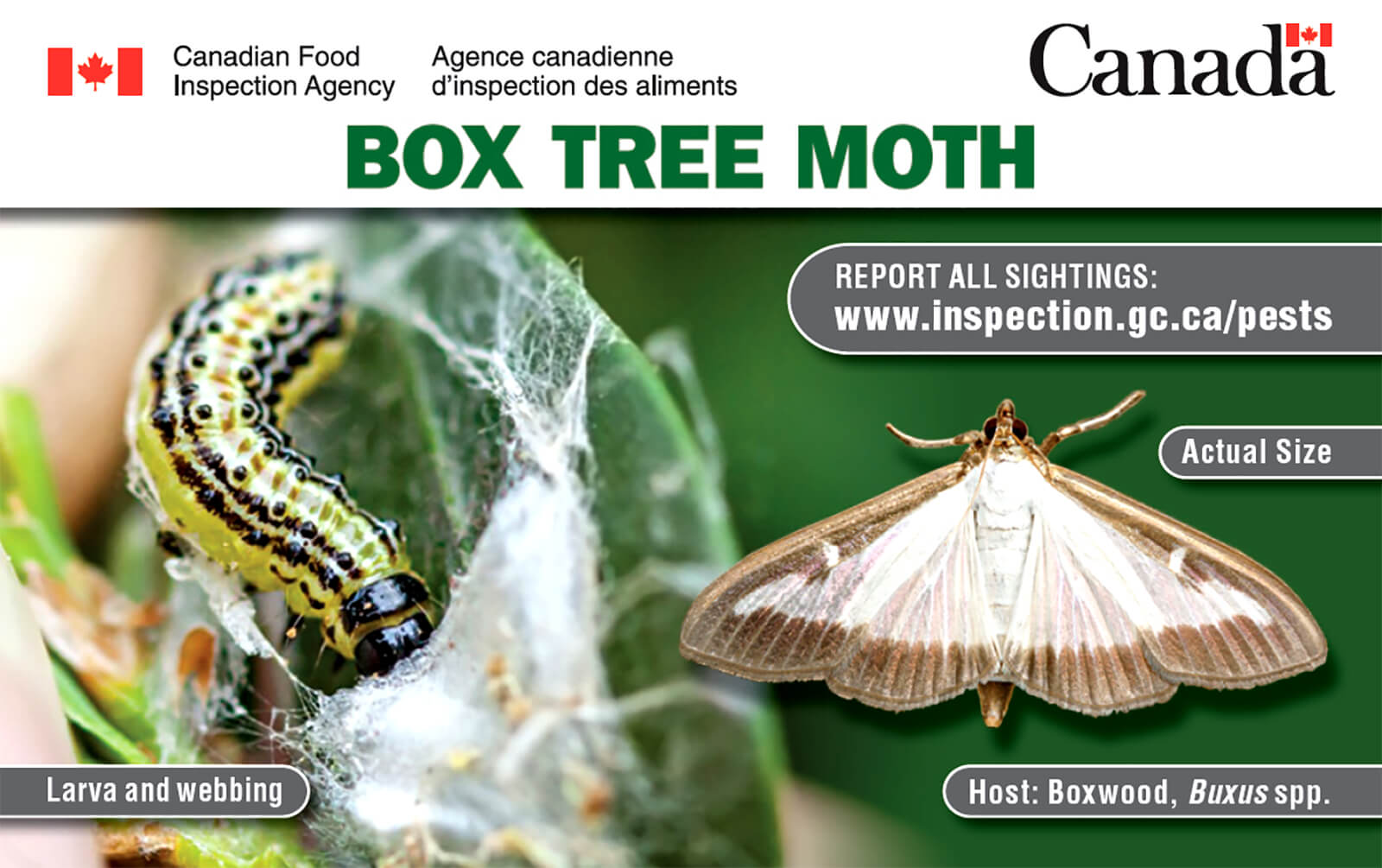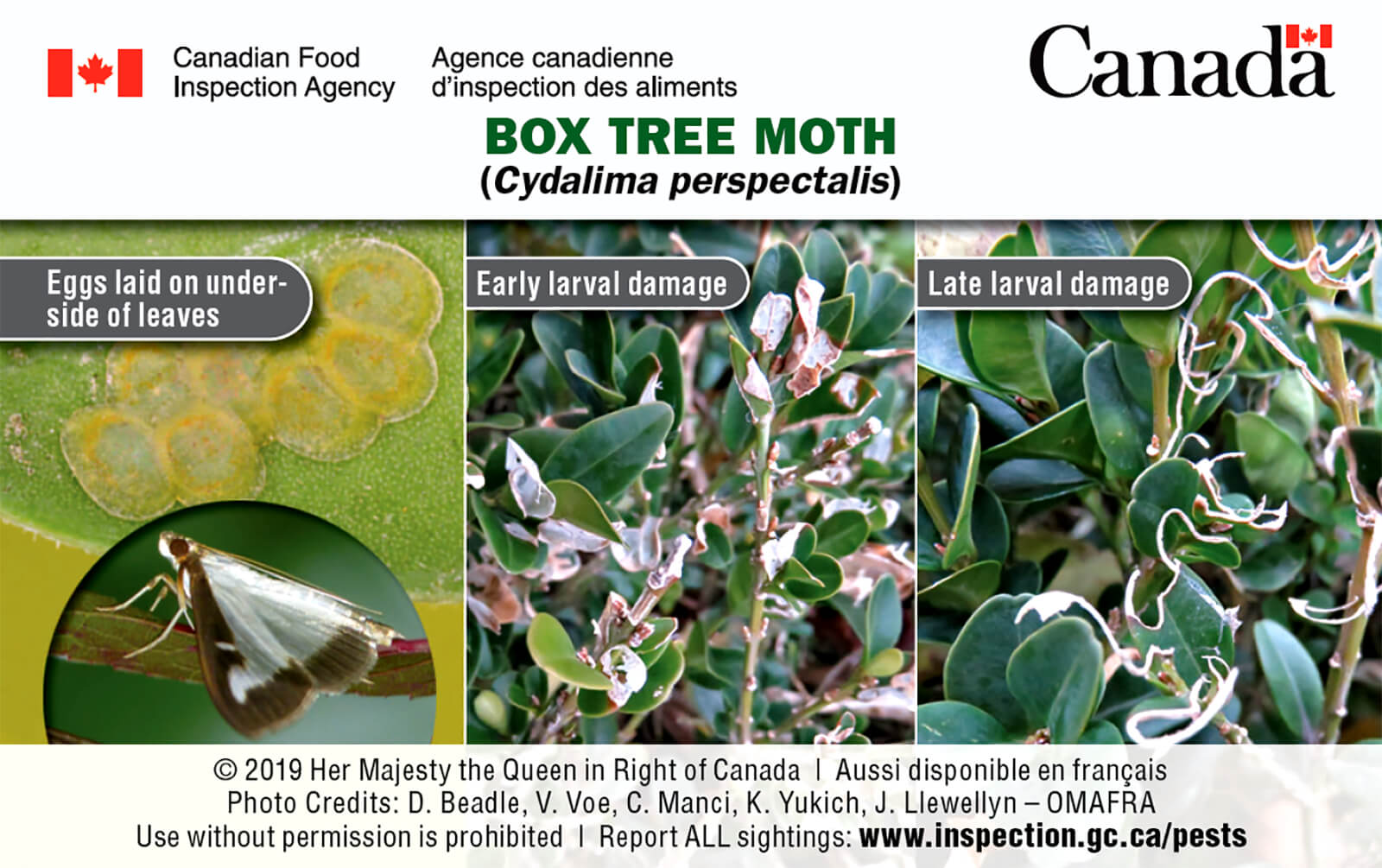April 17, 2019

Landscape Ontario leads program to control the spread of box tree moth
A Landscape Ontario-led control program is being undertaken in the spring and summer of 2019, with the objective of early control of the recently discovered box tree moth in Toronto. The program will help to stop this new, invasive pest before it has the opportunity to spread further.
Late in 2018, box tree moth (Cyladima perspectalis) was detected in Toronto by a citizen scientist, as reported in an online blog post at iNaturalist.org. In November, the Canadian Food Inspection Agency (CFIA) confirmed the presence of the box tree moth in an urban neighbourhood within Etobicoke. This is the first confirmed report of this pest in North America.
The control program will employ a targeted spray program at properties where box tree moth has been found. The biological insecticide, Dipel 2X DF (Btk) has been approved for use. It is expected that Dipel’s status as an effective biological will greatly enhance homeowner cooperation.
Dipel is most effective when sprayed at the first instar larval stage of the Box Tree Moth. The first appearance of this stage is expected to be in early May. The larval stage of this pest feeds on boxwood leaves and can defoliate the evergreen shrub. Box tree moth has the potential of spreading to many other boxwood plants during the season.
Late in 2018, box tree moth (Cyladima perspectalis) was detected in Toronto by a citizen scientist, as reported in an online blog post at iNaturalist.org. In November, the Canadian Food Inspection Agency (CFIA) confirmed the presence of the box tree moth in an urban neighbourhood within Etobicoke. This is the first confirmed report of this pest in North America.
Industry group taking the lead
A Box Tree Moth Industry Working Group has been formed and together with CFIA, Ontario Ministry of Agriculture, Food and Rural Affairs (OMAFRA), and Landscape Ontario, are working to educate growers, landscape professionals and homeowners about this new pest.The control program will employ a targeted spray program at properties where box tree moth has been found. The biological insecticide, Dipel 2X DF (Btk) has been approved for use. It is expected that Dipel’s status as an effective biological will greatly enhance homeowner cooperation.
Dipel is most effective when sprayed at the first instar larval stage of the Box Tree Moth. The first appearance of this stage is expected to be in early May. The larval stage of this pest feeds on boxwood leaves and can defoliate the evergreen shrub. Box tree moth has the potential of spreading to many other boxwood plants during the season.
Volunteers needed
Volunteers are needed to help support scouting efforts. Volunteers will be provided with the necessary tools to explain the pest and its significance to homeowners, to scout for the pest and to inspect boxwood plants for signs of pest damage. Properties where box tree moth are found will be communicated to LO to support the targeted spray program.These findings will be shared with CFIA to support their surveillance program. CFIA needs to better understand the extent of this pest before they can determine if a regulatory response is required.
Watch and report
Industry professionals are asked to be on the lookout for this pest when working with the Buxus species in their daily landscape work. Suspected sightings can be reported to inspection.gc.ca/pests or by using a handy smartphone app available at EDDmaps.org/ontario. This information will assist in evaluating the threat and will help direct the next steps for Canada.Possible border inspections
Growers and especially exporters of boxwood plants to the U.S. are advised that shipments of nursery stock to the U.S. containing boxwood plants may be inspected at the border at the request of the United States Department of Agriculture-Animal and Plant Health Inspection Service (USDA-APHIS) for the presence of box tree moth (Cydalima perspectalis). Box tree moth is currently not a regulated pest, however, if box tree moth is found, shipments can be refused entry to the U.S. Boxwood plants that are found to be free of this pest will be allowed entry to the U.S., if accompanied by the usual appropriate documentation (Phytosanitary Certificate).It is highly recommended that mixed loads of nursery stock entering the U.S. that include boxwood plants, be loaded so they can be easily inspected by border officials.

